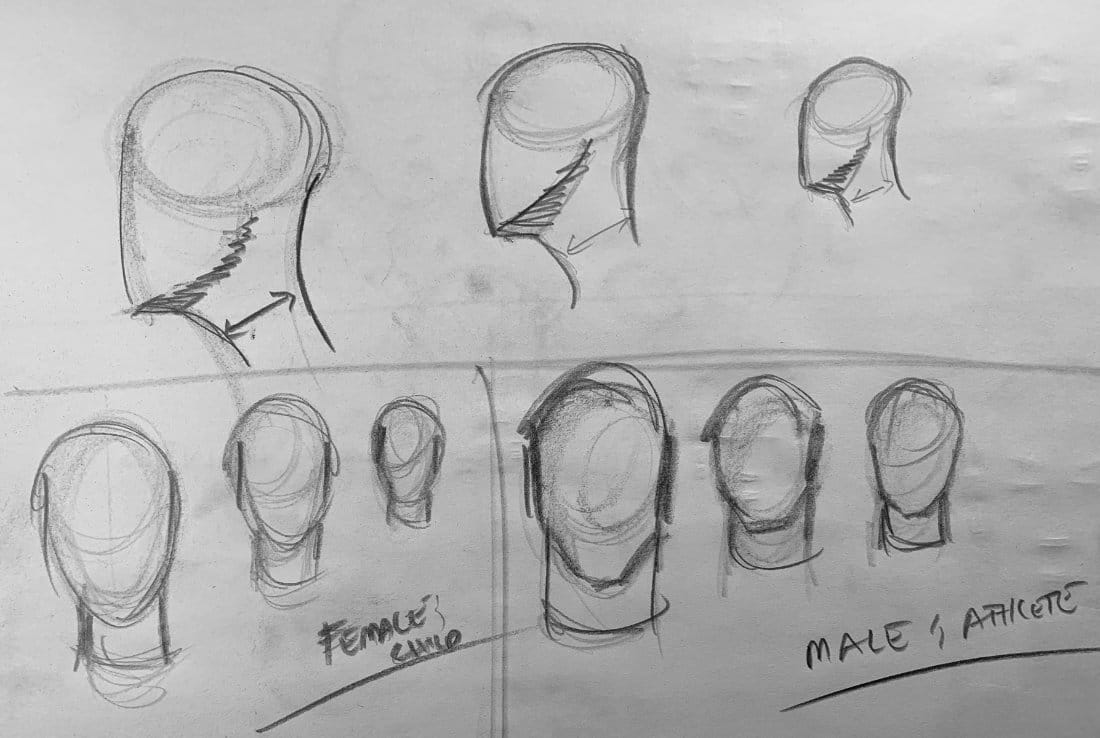How to Draw the Neck: Profile and Front View Demonstration
Apply neck anatomy knowledge with this drawing demonstration. Practice the digastric plane from profile view and cylinder form from front, varying width for different body types and scales. Includes nine examples showing female, child, male, and athlete neck proportions.

Now that you understand neck anatomy and construction, let's put it into practice. This demonstration shows nine neck drawing studies - three from profile focusing on the digastric plane, and six from front showing width variations for different body types and scales.
What You'll Learn
- Drawing the digastric plane from profile view
- Varying the digastric plane shape and volume
- Drawing neck cylinder from front view
- Narrower necks for females and children
- Wider necks for males and athletes
- Practicing at large, medium, and small scales
Video Demonstration
Profile View: The Digastric Plane
Starting with the skull construction we've practiced, I focus on the digastric plane under the chin. I draw where it starts, where it ends, then shade that shape to show the volume.
Each of the three examples varies. The first has standard proportions. The second has a longer, thinner digastric plane. The third has more volume, perhaps showing extra weight, so instead of running parallel, it angles downward.
I'm not working from reference - just using imagination to explore how this area changes from person to person. The key is getting the right amount of volume for the neck from profile view.

Varying Scales: Large, Medium, Small
Following the same practice from skull studies, I draw three different sizes. Drawing the same size repeatedly creates a crutch. You need to understand these proportions at any scale.
Front View: Width Variations
The bottom six studies show front views with deliberate width differences. The first three represent female or child proportions - narrower necks. The second three show male figures or athletes with significantly wider necks.
The main difference beyond neck width is jaw width. Males typically have wider jaws, which connects naturally to wider necks.
Why These Variations Matter
These could be athletes, action heroes, cartoon characters - the point is training yourself to make these proportional adjustments. Some of these necks are deliberately exaggerated (football player thickness) to practice the full range.
You'll always get specific proportions from your reference or model, but these generic sketches help you understand the principles.
Construction Process
Each study starts the same way - basic oval for the head, ellipse below for the mask of the face, then the neck. I use lighter lines (2B) for construction, then go over with darker lead (9B) so you can see the structure clearly.
The refinement pass is where subtle adjustments happen. Sometimes the neck is too long and needs shortening. Always look critically at your construction and make corrections.
The Straight Edge Reminder
Notice the straight lines along the sides where the circular shape flattens. This subtle characteristic appears consistently, though it varies by individual.
Your Practice Assignment
Draw 9 neck studies:
Profile (3 studies):
- Large with standard digastric plane
- Medium with longer/thinner digastric plane
- Small with fuller digastric plane
Front (6 studies):
- Large, medium, small with narrow neck (female/child)
- Large, medium, small with wide neck (male/athlete)
Focus on:
- Proper connection points to skull
- Accurate volume and width
- Varying your scales
- Light construction lines, darker refinement
Continue Learning
- Previous: Neck Anatomy & Construction
- Next: Head Construction Methods (coming soon)
- Course Hub: Complete Head Drawing Course
Continue Learning
If you enjoyed this hand drawing course, explore even more lessons on our Free Drawing Tutorials & Courses Hub — including the complete How to Draw – Beginner’s Course.
Want new tutorials delivered to your inbox? Subscribe here and get free lessons, tips, and inspiration sent directly to you.




